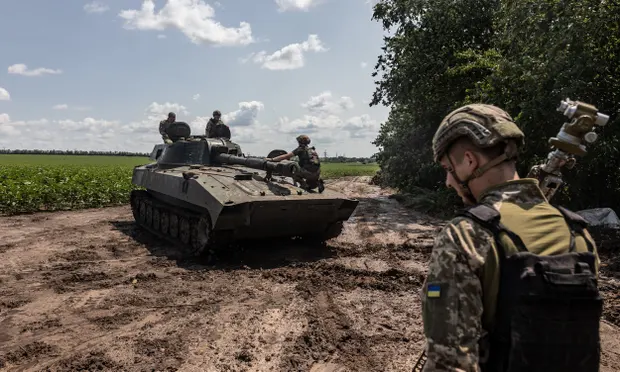
Image Source: The Guardian
By Mahimna Chourey, Student at the Central Foundation Boys School
Amidst the enduring conflict between Ukraine and Russia, wherein neither faction appears poised for an imminent decisive triumph, Ukraine has embarked upon the task of assessing the associated expenses and formulating a comprehensive recovery strategy. The question is, will Ukraine ever fully recover?
A brief history
Despite having come to wider attention only in the past year, the ongoing dispute traces its origins back to 2014, when Russia annexed Crimea from Ukraine in the wake of the latter’s “revolution of dignity.” On February 24, 2022, a significant escalation of the Russo-Ukrainian War transpired as Russia launched a full-scale invasion of Ukraine, resulting in the loss of tens of thousands of lives on both sides.
The factors driving the invasion exhibit a complex and multi-dimensional nature. Various analysts posit that Russia’s incursion into Ukraine stemmed from a combination of motives, including a quest to reaffirm its dominion over former Soviet territories and a strategic maneuver to divert attention from internal challenges within Russia. Additionally, Russia has consistently voiced opposition to Ukraine’s prospective membership in NATO and harbored apprehensions regarding the alliance’s expansion into Eastern Europe. The outcome of this conflict carries profound implications for the recalibration of power dynamics throughout the expanse of the former Soviet Union.
How much damage has been done?
As per an authoritative report by the World Bank, Ukraine incurred direct damages exceeding a staggering $97 billion due to the invasion perpetrated by Russia. Within the framework of outlining the fundamental repercussions, it is projected that the comprehensive process of demining and eliminating explosive remnants of war will necessitate a minimum investment of $11 billion over the next two to three years, alongside an additional requirement of $62.2 billion within the subsequent three to 10-year timeframe. Furthermore, the restoration and reconstruction of 816,157 housing units, constituting approximately 4.4% of the entirety of single-family homes, apartments, and dormitories, will be imperative over the next decade. Lastly, the devastation incurred encompasses the destruction of 27,121 kilometers, equivalent to approximately 11%, of Ukrainian roads, excluding residential road networks.
Russian forces have deliberately targeted Ukrainian power facilities, fuel storage depots, and water works, yielding significant consequences. The consequences are profound, leaving approximately six million individuals without access to electricity and heat as temperatures fall below zero in many parts of the country. The gravity of the situation extended to the disconnection of three nuclear power plants from the grid owing to the impact of airstrikes.

Source: Statista
Combining this with a staggering tally of 703 assaults targeting Ukrainian healthcare facilities, this flagrant disregard for humanitarian law, as highlighted by Dr. Hans Kluge, the Regional Director for Europe at the World Health Organization (WHO), signifies a grievous breach of ethical principles. Such actions may potentially warrant classification as war crimes under the provisions of the Geneva Convention.
In addition to the aforementioned direct damages, Ukraine has incurred substantial losses amounting to $252 billion due to disruptions in its economic flows and production, alongside the additional financial burden associated with the ongoing conflict. The severed trade relationships with Russia would also make it difficult for Ukraine to source mineral fuels, nuclear reactors, vehicles, and electrical machinery and equipment. Furthermore, the displacement of approximately one-third of the Ukrainian population is projected to significantly escalate the poverty rate from a mere 2% before the war to an anticipated 21%. Lastly, the most profound and tragic consequence has been the loss of human lives, as Ukraine has mourned the devastating toll of 124,500 to 131,000 casualties through Russian attacks.
Will Ukraine recover?
To date, the European Union (EU) has allocated a substantial amount of €30 billion (£26 billion) to Ukraine within the past year. In response to the crisis, funds have been redirected from energy and cohesion programs. Moreover, on Tuesday, the EU made an additional commitment of €50 billion in the form of loans and grants. Demonstrating solidarity, both the United Kingdom and the United States have pledged financial support, with the UK promising $3 billion and the US committing $1.3 billion.
Whilst this does sound like a lot of money, it’s not enough. According to Arup Banerji, the Regional Country Director for Eastern Europe at the World Bank, Ukraine’s initial estimations suggesting a required investment of $750 billion for economic reconstruction appear to be extrapolated from the extent of the damage incurred. Nevertheless, the actual figure paints a disheartening picture, as the projected cost for reconstruction and recovery stands at $411 billion (£323 billion) after a year of conflict. With nearly 90 percent of the nation’s population in poverty, a substantial funding requirement of $250 million per month emerges as a necessity to mitigate partial income losses for approximately 2.6 million individuals. Moreover, to provide the most vulnerable segments of society with a basic income of $5.50 per day, the estimated monthly expenditure would amount to $430 million, as outlined by the United Nations Development Programme (UNDP).
The ongoing war has not only impeded Ukraine’s present economic growth and development but also poses a significant obstacle to prospects. Repercussions are evident in the closure of half of Ukraine’s businesses, while the remaining enterprises struggle to operate at a considerably diminished capacity. Furthermore, the strained trade relations with Russia continue to pose a significant challenge until a viable alternative market is identified, while the extensive damage inflicted upon critical infrastructure and energy plants is poised to severely curtail production and transportation processes for many years to come.
The most damaging loss of all, however, has been the irreplaceable loss of lives. The toll of 130,000 lives not only significantly diminishes Ukraine’s productive capacity but also engenders deep-seated emotional trauma among its people, hindering health, happiness, and productivity for generations to come. The most formidable obstacle between the current state of Ukraine and the envisioned revitalization that would reinstate its former vibrancy lies in the collective ability of its citizens and government to nurture hope, fortify emotional resilience, and instill unwavering confidence in rebuilding the nation. Then, and only then, will the nation recover in the truest sense.

Mahimna Chourey
Mahimna is a young economics enthusiast, displaying a profound passion for blogging and social service. He has developed a keen interest in the intricacies of macroeconomics and developmental economics, and envisions pursuing a major in economics at the university level. His primary objective is to disseminate the knowledge of economics across the globe and champion the significance and applicability of this subject in mitigating the global financial divide.
excellent issues altogether, you just received a new reader. What could you suggest in regards to your put up that you made some days in the past? Any certain?